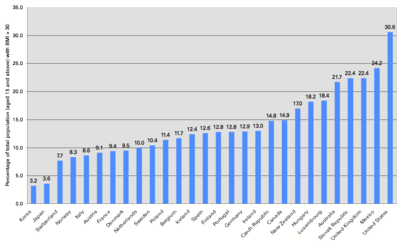FIGHTING fat has become a national obsession. And while fat jokes used to be the staple of every stand-up comic, the health problems that stem from being overweight are no laughing matter.
"Obesity is a national problem and it is associated with over $90 billion in health-related costs," says Dr. Terry Mason of Mercy Hospital in Chicago, who is also medical director of the Center for New Life.
An estimated 64 percent of U.S. adults aged 20 years and older are either overweight or obese--defined as having a body mass index (BMI) of 30 or more, according to the National Center for Chronic Disease Prevention and Health Promotion. "African-American women suffer the most from obesity-related health problems," Dr. Mason adds.
According to the American Obesity Association, 78 percent of African-American women are overweight; 51 percent are obese. Among African-American teens, 46 percent are overweight and 27 percent are obese.
It is also a major problem in children and is responsible for the rise in type-2 (non-insulin dependent) diabetes, Dr. Mason says. An overweight person is more likely to develop health problems such as heart disease, stroke, diabetes, cancer (such as colon cancer, endometrial cancer and postmenopausal breast cancer), gallbladder disease, sleep apnea (interrupted breathing during sleep), osteoarthritis, complications of pregnancy, poor female reproductive health (such as menstrual irregularities, infertility, irregular ovulation).
"As a nation, we need to respond as vigorously to this (obesity) epidemic as we do to an infectious disease epidemic ...," says Dr. Jeffrey P. Koplan, director of the Centers for Disease Control and Prevention.
How do we combat it? "We have eaten ourselves into this problem and we have to eat ourselves out of it," Dr. Mason says. Eating the right kinds of foods, portion control and a balanced program of exercise is the key to weight loss, he and other medical experts say.
For celebrities and others, fighting obesity and winning is often a lifelong battle, with major and minor victories along the road. Grammy Award-winning producer Randy Jackson is a 20-year music industry veteran. And for most of those 20 years he has been in a losing battle with his weight. He had weight-related health problems, suffering from sleep apnea and type-2 diabetes. He recently lost 100 pounds, going from 329 to 229 through gastric-bypass surgery. Jackson told People magazine that the surgery was "the best thing I have ever done." His surgeon, Dr. Mal Fobi, medical director of the Center for Surgical Treatment of Obesity in Hawaiian Gardens, Calif., near Los Angeles, has also performed his patented stomach reducing surgery on actress Roseanne Barr and blues great Etta James, among countless others.
Superstar rapper and producer Missy Elliott also says she was told by her physician to lose weight due to weight-related health complications. In her case she was told she might have a stroke. She told JET that she lost more than 50 pounds after dramatically altering her diet and beginning a regular exercise routine. By sticking to a low-sodium diet and working out regularly she has kept the weight off for nearly two years.
For Samantha Burton-Majied, the daughter of legendary song stylist Nancy Wilson, faith in God and a recovery program for food addiction led to a dramatic 300-pound weight loss. "God was the impetus behind my weight loss," she told a reporter. "Through prayer, meditation, a sponsor and a lot of friends, I conquered the weight loss." She is now smaller than she has ever been, dropping from a size 32 to a size 8.
Another famous daughter faced a health crisis that pushed her to a dramatic fork in the weight-loss road. Nora Brooks Blakely, daughter of the late Pulitzer Prize-winning poet Gwendolyn Brooks, is now 75 pounds lighter and worlds healthier. After an "unexpected and incapacitating blinding headache," she went to a doctor and was given a dismal diagnosis. "The news was pretty bad: high blood pressure, perilously close to becoming a diabetic, triglyceride readings so high they couldn't even measure my cholesterol, and I was carrying way too much weight on my 5-foot-8 1/2-inch frame." Although she had lost and regained weight through the years, this time she lost the weight and kept it off. She attributes a "new philosophy" to her weight-loss strategy, drinking 12-16 glasses of water a day and an active exercise plan. Her new philosophy has involved accepting her own reality. "For me," she says, "accepting that changing the way I look at food and health in my life is an ongoing process. Accepting, as a fact, that each step forward, no matter how small, is a step in the right direction, for which, I praise myself [while I inhale and revel in outside appreciation without becoming ruled by it]."
The new cute leather and denim shorter skirts she's now able to wear are a big plus, but she says at age 52, "it's all about health. I'm definitely a work in progress. This is not the end of the road, but it is a hallowed moment on it."
COPYRIGHT 2004 Johnson Publishing Co.
COPYRIGHT 2004 Gale Group




